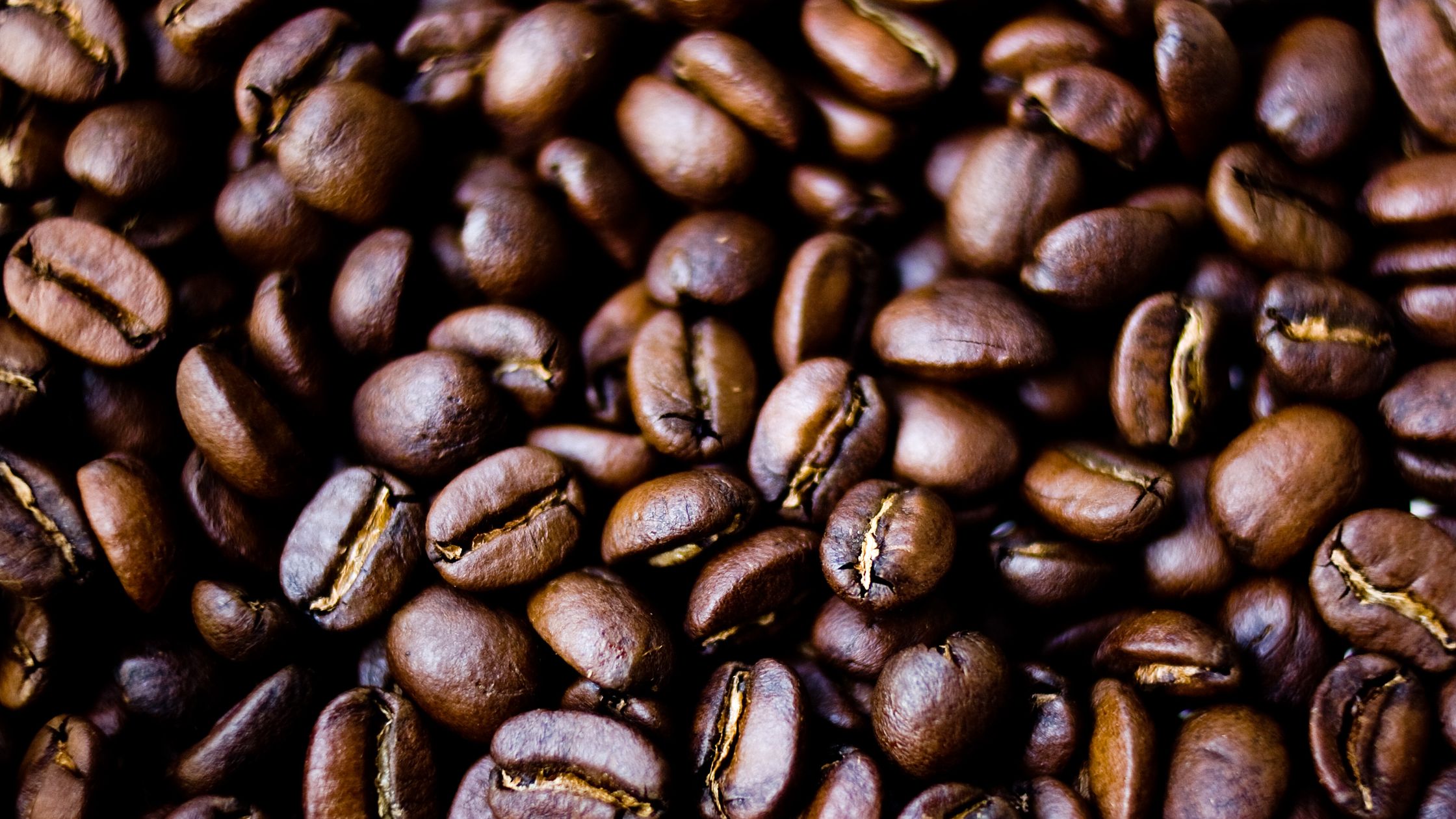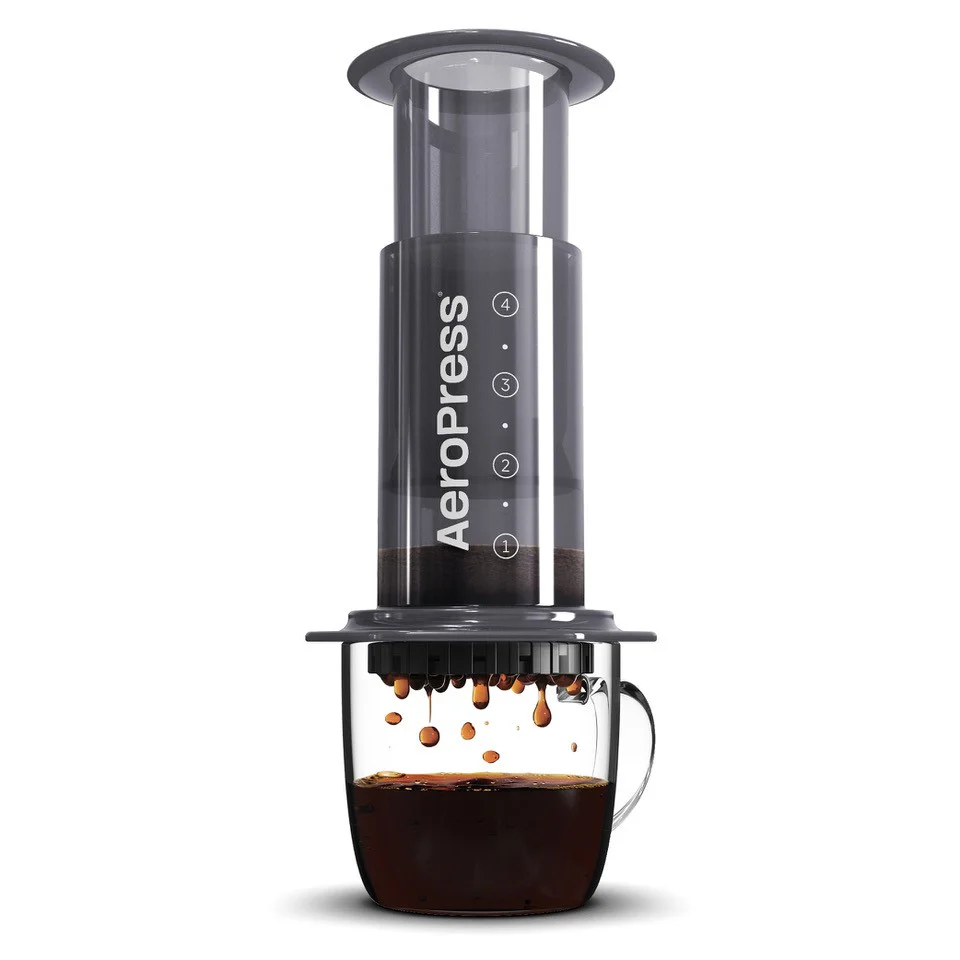- Beans: “Festivus Roast” (Indonesia/Central America/South America)
- Dark roast (7/8)
- Roaster: Zeke’s Coffee (Baltimore, MD)
- Roast date: 11/27/2023
Initial Recipe
- JX: 2 turns (Grind setting 20)
- 83°C brew water / 99°C bypass water
- 20g coffee / 200g brew water + 50g bypass water (1:12.5)
- Two paper filters, pre-moistened
- Recipe: An AeroPress Recipe by Tim Wendelboe
- Set AeroPress up in standard orientation and rinse filters
- Add 200g water to AeroPress and return kettle to base
- Stir 3 times back to front
- Insert plunger and pull up to stop dripping
- Turn kettle up to 99°C
- Steep for 60 seconds
- Remove plunger and stir 3 times back to front again
- Insert plunger and press slowly
- Add 50g bypass water
Best Recipe
- JX: Grind setting 16 (1.5 turns plus 3 clicks, or 48 total clicks)
- 85°C brew water (no bypass)
- 18g coffee / 225g brew water
- Prismo with metal filter
- Insulated mug (Hydro Flask or similar)
- Set AeroPress up in standard orientation and add ground coffee
- Start timer and add 225g water, finishing at around 0:35, and stir 4-5 times back to front
- Cover AeroPress to minimize heat loss (I set the plunger on top)
- Steep until around 2:10 (1 minute 35 seconds)
- Stir 4-5 times back to front again
- Insert plunger and press slowly (I use just enough pressure to keep the Prismo valve open)
- Put lid on mug immediately to retain heat
The “initial recipe” turned out really good the first time I brewed it. Compared to the pourover cups I’ve been making recently, it was smoother and had more of a chocolaty note to it. It makes me wonder if I can tweak the pourover recipe to get a similar result. I used a finer grind setting for the AeroPress, but I don’t think I’d want to go much finer with the pourover, as it already had a slight edge of bitterness. The AeroPress cup had no hint of bitterness at all. It definitely seemed stronger than the pourover (maybe a little too strong, actually 😀), so I’m wondering if the longer steep time leads to more bean extraction at the lower water temperature. I suppose that I if I wanted to reduce the caffeine hit, I could skip the bypass and brew 200g water with 16g coffee, but I liked that the hotter bypass water brought the cup up to (what I consider to be) an ideal drinking temperature. I’ll have to give this some thought.
12/6: The same recipe with 18g coffee (1:14) had similar flavor, but (predictably) less body. I think I’d be best off brewing a little bit less coffee at a stronger ratio. A few possibilities:
- 200g water with 16g coffee and no bypass
- 160g water with 16g coffee and 40g bypass (total 200g)
- 180g water with 18g coffee and 45g bypass (total 225g)
All 3 recipes keep a 1:12.5 ratio. #2 and #3 are identical to 12/5’s recipe, just with proportionally less water and coffee. I think I’m going to try #3 tomorrow.
12/7: I’m not sure why, but option #3 (from above) turned out really bad. It had no flavor at all, and had I not known better, I would have thought I was drinking hot water. Maybe I did something wrong, as it seems like simply reducing all of the quantities by 10% shouldn’t have that big of an effect. Whatever the case, I’m probably not going to try #2 or #3 again.
12/8: The same recipe that was great on 12/5 (20g coffee at grind setting 20, 200g brew water at 83°, 50g bypass at 99°) was not good today. It was marginally better than yesterday’s, but still watery and lacking in flavor. Not sure what the reason is for the inconsistency. I thought perhaps that yesterday I had forgotten to tighten the filter cap on the AeroPress, but that was not the issue today. I don’t think there was much variation in my brewing technique, so I’m a little bit perplexed.
12/9: Decided to shake things up today: 18g coffee at grind setting 15, 200g brew water at 83°, 25g bypass at 99°. This is a much finer grind and a lower ratio of bypass to brew water. Due to the fine grind, there was less initial drip-through, and more plunging resistance. I pressed very slowly, backing off at any hint of back-pressure. This was a much better cup than either of the previous two. I guess the finer grind was the difference-maker, but it doesn’t explain why the first two cups at grind setting 20 were good, but the next two were under-extracted.
12/12: I’ve been brewing the 12/9 recipe for a few days now, and the main issue is that the coffee cools too fast after brewing, even when I brew it into an insulated Hydro Flask mug. I may try nudging the water temperature up closer to 90 to see what happens. If it ends up tasting bitter, I can make the grind slightly coarser.
12/13 and 12/14: I picked up a Fellow Prismo this week, mainly because I wanted to be able to brew “drip free” without having to invert the AeroPress. Yesterday, I brewed with 18g coffee at grind setting 20, 200g brew water at 85°, and 25g bypass water at boiling. It definitely had a different flavor from the same recipe brewed with the standard cap and filter. It had more of a smooth mouthfeel, but maybe not quite as strong. No hint of bitterness. Today, I tried 17g coffee at grind setting 20, 200g brew water at 90°, and no bypass. The cup stayed hot longer, but the taste had a little bit of bitterness to it. I am going to continue playing around with the Prismo over the next several days, and see if I can get something dialed in. (Note– did I actually use setting 20? Had been using 15 since 12/9).
12/15: 200g brew water at 85°, 20g coffee at grind setting 15 (confirmed), 25g bypass water at boiling. I meant to brew this at 1:12.5, but mistakenly used 250g as the divisor, and thus ended up at 1:11.25. Regardless, for whatever reason, this cup was watery and flavorless. The common thread among the bad cups I’ve gotten seems to be the 1:10 brew ratio. I found a really good article that discusses the relationship between water and coffee volume and how it affects strength vs extraction. It’s the best, most succinct write-up on the subject that I’ve found. In a nutshell, (more coffee with the same water volume) == (more strength but less extraction [flavor]). This would seem to explain why the coffee tastes better when I brew 18g coffee to 200g water, vs 20g to 200g. The article recommends dialing in the strength first, then adjusting extraction by varying grind size, temperature, and/or immersion time.
12/16: 200g brew water at 85° (overshot slightly, so probably more like 205g), 18g coffee at grind setting 16. I also added a (dry) paper filter in front of the metal Prismo filter. I steeped from 0:35 until around 2:05 (including the initial stir), which is about 30 seconds longer than I had previously been steeping. I stirred in a back-and-forth motion and pressed slowly. This was much, much better than yesterday’s cup. I tried it with no bypass water initially, but it was too strong, so I added around 20g which brought it to probably about 1:12.5. I think that the combination of lower ratio of coffee to brew water, plus longer steep time, led to better extraction. I’m not sure if the paper filter made any difference — I added it mainly to see if it would help with cleanup, but it was kind of a push. It saved me having to rinse off the metal filter, but I still had to shake the two out of the Prismo cap and pry them apart, which isn’t really any less messy.
12/17: Brewed the same recipe as yesterday, and got another very good cup. For the record, the exact steep time after finishing the pour was 1 minute 35 seconds (0:35 until 2:10). I left out the paper filter this time, and did not notice much difference. The longer steep time seems to be the big difference-maker with this recipe.
12/19: Decided to try brewing with the full amount of 225g water (at 85°) and no bypass. I kept everything else the same (18g coffee at grind setting 16, 1 minute 35 second steep time, slow press). I think this turned out a little better than brewing with 200g water + 25g bypass. However, it’s definitely important to use an insulated mug to keep the coffee from cooling too quickly.
12/22: Used up the last of the beans. I’ll likely use “best recipe” (above) as a starting point for the next dark roast I buy, and see how it turns out.

